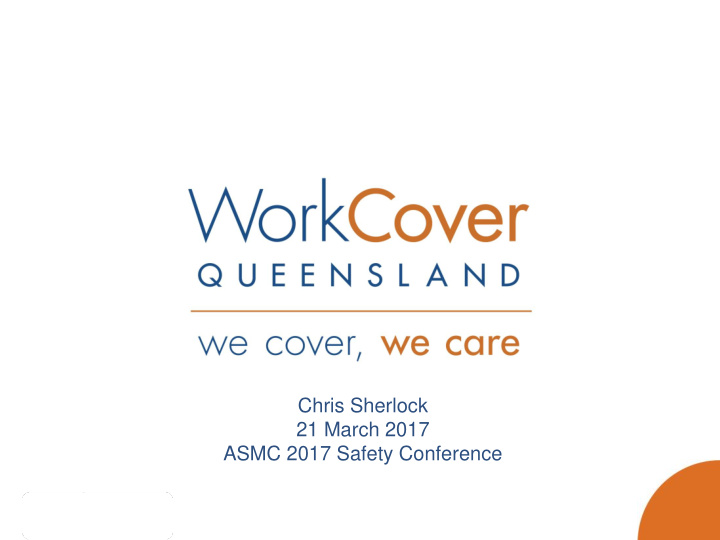



Chris Sherlock 21 March 2017 ASMC 2017 Safety Conference
Working together
All industries - Injury by type 2015/2016 WorkCover Queensland data 2015-2016
Claim numbers by industry 12,000 Statutory Claims 10,000 Common Law Claims 8,000 6,000 4,000 2,000 0 WorkCover Queensland data 2014-2015
Musculoskeletal Injuries We know that statistically these are when musculoskeletal injuries occur in Manufacturing
Sugar Manufacturing
Common developmental factors characteristics present in young people aged between 15 and 24. Intellectual • The brain does not finish developing until the mid-20s, which means the ability to perform complex tasks, problem-solve and multi-task can be lower in young workers. The areas of the brain that develop last are typically those that are responsible for logical decision making, problem solving and controlling impulses. Physical • Because young people are still developing their strength, fitness and coordination, they need more sleep and recovery. This means that tasks, equipment and the work environments that have been designed for the majority of workers may not meet the needs of young workers. Social • A desire to impress others and fit in means young workers typically model their behaviour (right or wrong) on their co-workers, while avoiding asking questions and raising concerns.
Generational Factors Learning style Young workers have typically been exposed to interactive and self-directed learning from a range of sources. Traditional, classroom-based forms of training should be complemented by opportunities for ‘hands - on’ experience. Information and communication Young workers may respond well to information provided using images and technology, rather than highly technical, written documents. Communicating through a range of methods, including using technology that young people are familiar with alongside traditional methods, such as one-on-one discussions and team meetings, can be effective. Risk perception Young workers may lack the ability to perceive when a situation becomes dangerous, and as a result, be less likely to ask questions and identify and report safety concerns. Providing opportunities to continually develop their risk management skills can help them make more informed decisions about risk.
Provide information, training, instruction and supervision • Expecting a young worker to ask for help if they need it relies on a very big, and most likely false, assumption that workers both feel confident enough and know when to speak up. • Using the ‘Tell me. Show me. Watch me.’ approach to workplace training will be the most effective way to ensure young workers understand how a task should be done.
Young Worker Safety Toolkit • The Young Worker Safety Toolkit is a great starting point for employers of young workers to work through these engagement principles and determine how to apply them in the workplace. The toolkit includes a checklist that can be used to create a tailored action plan and explains the role of stakeholders in young worker safety, including employers, supervisors and managers, work health and safety decision-makers, education and training providers, parents and caregivers, and youth service providers. More information Young Worker Safety Toolkit Young workers – collection of information and resources to assist employers in managing the health and safety of young workers Good work design for young workers webinar recording Designing work for your workforce – younger and older workers podcast
Recovery – health benefits of work The longer someone remains off work the less likely it is they will ever return. • 70% chance of ever 20 days off returning • 50% chance of ever 45 days off returning • 35% chance of ever 70 days off returning
Employer best practice See how CV Services Group makes safety and • Keep your workplace safe return to work a priority • If accidents occur, encourage stay at work • Offer suitable duties • Focus on what the worker can do • Safety measures and suitable duties do work – case study
Lodging a claim
Tools to help you Online services Webinars Forums Site visits Premium forecasting Individual and industry trend analysis Return to work strategies and suitable duties plans Website
What can you do? Suitable Support duties to Prevent your encourage injuries workers return to work Lodge claims Open and quickly to get regular medical communications treatment early
worksafe.qld.gov.au 1300 362 128
Recommend
More recommend